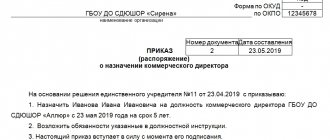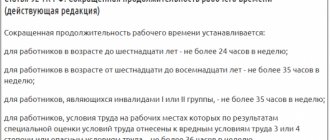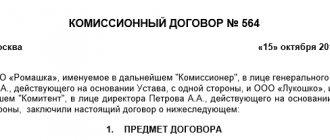What might be the reason for an investigation?
The job description of any employee contains a section that prescribes responsibility for certain violations. Typically there are clauses about:
- causing damage to the company,
- damage to inventory items,
- non-compliance with labor discipline,
- negligent performance of labor functions,
- disclosure of trade secrets, etc.
All these offenses can entail quite serious consequences for the organization and cause an internal investigation. And if this happens, then the internal “investigation” will help to establish the true cause of the incident and determine the degree of guilt of a particular employee.
Internal investigation under the Labor Code: algorithm
Procedure for carrying out an investigation:
1. Creation of a commission and issuance of an order. Usually the commission consists of at least 3 people: for example, a lawyer, an economist and a personnel worker.
2. Direct work of the commission with studying all sides of the case, collecting evidence, interviewing witnesses, etc.
3. If the guilty employee is known, he writes an explanatory note.
4. Preparation of an investigation report and its signing by all participants in the proceedings.
During the investigation, mandatory points are established, without which recovery of damages is impossible:
- whether actual damage was caused and in what amount,
- existence of financial liability under Article 239 of the Labor Code of the Russian Federation,
- the presence of guilty actions or inaction of the employee,
- the presence of a connection between the actions (inaction) of the employee and the consequences that occur.
In fact, an internal investigation is a direct procedure for studying case materials that prove the guilt of the offender.
Investigation procedure
In some types of offenses, conducting an investigation is the responsibility of the employer, while in other cases it is a voluntary initiative of the manager. If such an investigation is not carried out, the employee will subsequently be able to appeal the disciplinary punishment to which he was subjected.
However, the investigation procedure is quite labor-intensive and responsible, so a special commission is appointed for it by a separate order. Its main task is to clarify the circumstances of the incident, talk with the alleged culprits, establish the degree of their guilt, and calculate the damage caused to the organization.
The commission must include at least three people from different departments of the company. All of them must be sufficiently qualified and competent specialists to conduct an investigation efficiently, at the proper level, analyzing all the motives, cause-and-effect relationships and other circumstances. In this case, you need to act extremely carefully, avoiding violation of workers’ rights. As a rule, the commission includes:
- representative of the internal security service,
- lawyer,
- accounting department employee or economist,
- technical worker, for example, engineer, etc.
The commission may also include the head of the company.
Document flow and order
If there are grounds for conducting an official investigation, a special commission is created to study the circumstances, assess the amount of damage and bring in the culprit. The composition includes employees of the unit in which the deviation was made and representatives of the relevant services. For example, when a shortage is identified, accounting employees are involved, when the fact of theft is established, specialists from the internal security service, and when a bribe is received, responsible persons from the anti-corruption department are involved.
Actions of the commission
How to conduct an internal investigation? The beginning is the creation of a commission of enterprise employees who are not directly or indirectly involved in the occurrence of the incident. The organization draws up an order listing the composition of the commission, which includes at least three employees. If necessary, it is allowed to involve third-party experts.
The powers of the commission include:
- recording the essence of the event;
- assessment of the damage caused in quantitative and monetary terms;
- the causes and significant conditions leading to the incident;
- the degree of guilt of the official;
- the circumstances of the violation committed;
- measures taken to hold the employee accountable;
- preventive measures to further prevent similar offenses.
The commission requests written explanations from the perpetrators and persons who can “shed light” on the commission of the offense, explain the motives and be indirectly involved. To conduct an objective analysis, a notification is sent to the offending employee with a proposal to draw up an explanatory note. In case of refusal, an act is drawn up that does not affect the conclusions. The assessment of the results is documented in an act.
Organization of document flow
In addition to additional documents affecting the degree of guilt of the employee, drawn up at the discretion of the commission members, it is necessary to draw up mandatory documents in chronological order:
- Issuing an order or directive to conduct a workplace investigation. The document indicates the appointed leader, the names of the members of the commission and the period of the meeting are listed.
- Notification to the person at fault. The purpose of the document is to propose the preparation of an explanation to the guilty person in order to bring maximum objectivity to the conclusions. An internal investigation by the Labor Code, Art. 193, without a proposal and allotting 2 working days for an explanation to the offending person, is considered invalid for the imposition of a disciplinary sanction. A refusal, expressed orally or in writing, is formalized by an appropriate act.
- Employee explanation. The document is studied by the commission and influences the verdict. Offering to provide explanations is the employer’s responsibility, and drawing up or refusing to do so is the employee’s right.
- Act on the results. The document contains a narrative part with a detailed description of the incident, details of the verification process and the conclusions of the commission are recorded with attachments of documentary evidence.
Download the Order for an internal investigation against an employee (form) (27.0 KiB, 712 hits)
The accompanying documents include explanations from employees about the negligence of the responsible person, for example, about the absence of strangers from the immediate workplace and free access to the premises, failure to close the warehouse or entrusted facility during technical and lunch breaks, etc.
Registration of the result
The resulting document of the internal investigation is the drawing up of a report on the work performed, sealed with the signatures of representatives.
In the process, mandatory points are established, without which it is impossible to recover the damage caused:
- Estimation of actual size. The data is taken from the accounting registers of analytical (by name and quantity) and synthetic (by residual value) accounting.
- Exclusion of the material component in relation to the employee according to the circumstances under study specified in Article 239 of the Labor Code of the Russian Federation:
- force majeure – exceptional events and natural disasters;
- normal degree of economic risk - a situation where achieving a goal with minimal losses could not be achieved by other means;
- extreme necessity, in which other behavior is fraught with harm to health (threat of physical harm);
- failure by the employer to fulfill the obligation to create appropriate conditions to protect the safety of inventory items.
- Statement of guilty actions of an employee in the form of bribery, theft or guilty inactions in the form of negligence, which led to shortages and the possibility of theft by other persons.
An official investigation is a scrupulous procedure for studying the cause-and-effect relationship between the occurrence of consequences and the degree of guilt of the employee, considering the circumstances and assessing the possibility of obtaining a different result.
The result is documented in an act, the unified form of which is absent. However, the document must contain mandatory information:
- name of the organization, date and place of compilation;
- listing the chairman and members of the commission appointed by order of the head;
- brief information about the person whose performance of duties was checked;
- designation of the purpose of the event;
- mitigating or aggravating circumstances identified during the investigation;
- verdict on the guilt or innocence of the citizen and proposals of the commission.
The drawn up act may contain attachments in the form of explanations from employees confirming the presence or absence of selfish goals or malicious intent on the part of the perpetrator of the incident. The final decision is made by management and formalized by order.
Dates
Often the result of the event is the imposition of a penalty. Consequently, the time frame for conducting an internal investigation under the Labor Code cannot exceed the permissible period for imposing a disciplinary sanction.
In accordance with Article 193 of the Labor Code of the Russian Federation, punishment is applied within one month from the date of discovery of the offense. The period excludes days of absence for a reason known to management - being on sick leave, being on vacation of all types. If there is a trade union organization or other elected activist, the time given to activists to familiarize themselves with the materials is excluded.
The day of detection is the date when the immediate supervisor became aware of the commission of an offense. However, after the expiration of the six-month period, no penalty is imposed unless a criminal case is opened by law enforcement agencies.
Investigation results
After the investigation, the commission makes its decision in a special act, which, if there is evidence of the employee’s guilt, serves as the basis for imposing disciplinary punishment on him.
Usually in such cases the punishment comes in the form of a reprimand or even dismissal; rarely does anyone manage to get away with a reprimand. In addition, the employee may also incur financial liability (if facts of intentional damage to the company’s property have been proven).
In special situations, an internal investigation may serve as the basis for the initiation of an administrative or even criminal case, and may also lead to the filing of a civil lawsuit against the culprit.
How to create an order
To date, there is no standard unified sample order for an internal investigation against an offending employee. Enterprises and organizations can write it in any form or use a template developed within the enterprise, based on its needs (in this case, the form of the order must be approved in the company’s even policy).
The order for investigation must include a number of basic information. This:
- name of the employing company,
- personal data of the employee: his position, full name, information about the incident,
- link to the base
- information about the persons responsible for its implementation.
Also, the order must be numbered and dated . It is not necessary to put a stamp on the document, because... as of 2020, the legal requirement for legal entities (as previously for individual entrepreneurs) to use stamps and seals in their work has been abolished.
Deadlines
There is no specific time frame for conducting an official investigation under the Labor Code of the Russian Federation. The legislator does not limit the employer in this, however, he establishes a number of rules.
According to Art. 193 of the Labor Code of the Russian Federation provides for the following reservations regarding the timing of internal inspections:
- Disciplinary action can be taken against an employee no later than one month from the moment violations are discovered. It can be concluded that the investigation should not go beyond the specified time frame.
- The employee is obliged to give an explanation for the misconduct no later than two days from the date of filing a claim by the employer. The refusal is documented.
The Labor Code of the Russian Federation does not directly stipulate the period for conducting an official investigation.
Note! The one-month period of application of a disciplinary sanction is not counted towards the period of temporary incapacity for work, as well as the time for providing explanations to the employer.
Sample order
- At the beginning, on the left or right (it doesn’t matter), the name of the organization is written, indicating its organizational and legal status (i.e. CJSC, OJSC, individual entrepreneur, LLC), as well as the date and number of the document.
- After this, the word “Order” is written in the middle and its meaning is briefly conveyed a little lower (in this case, “about an official investigation”).
- First, a “preface” is entered here, that is, information about the emergency situation (violation, misconduct, etc.) and the employee who committed it, and the date of the incident is indicated.
- Then the order itself is written in separate paragraphs. Here the composition of the commission is appointed (the positions of the company’s employees, their surnames, first names, patronymics are indicated) with the chairman and ordinary members identified, their goals and objectives are prescribed, including drawing up a conclusion on the investigation.
- A person responsible for carrying out the order is appointed as a separate item.
- After this, a reference to the basis (with its number and date) is entered into the document.
- At the end, the order is signed by the manager, as well as all the employees mentioned in it.
Then the main part of the order is located.








